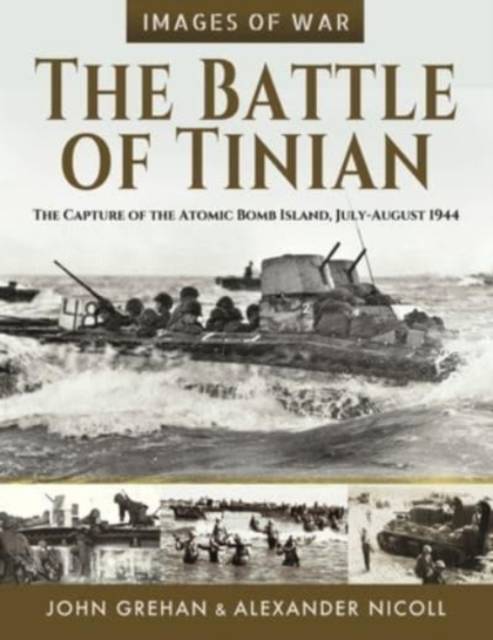
Je cadeautjes zeker op tijd in huis hebben voor de feestdagen? Kom langs in onze winkels en vind het perfecte geschenk!
- Afhalen na 1 uur in een winkel met voorraad
- Gratis thuislevering in België vanaf € 30
- Ruim aanbod met 7 miljoen producten
Je cadeautjes zeker op tijd in huis hebben voor de feestdagen? Kom langs in onze winkels en vind het perfecte geschenk!
- Afhalen na 1 uur in een winkel met voorraad
- Gratis thuislevering in België vanaf € 30
- Ruim aanbod met 7 miljoen producten
Zoeken
The Battle of Tinian
The Capture of the Atomic Bomb Island, July-August 1944
John Grehan, Alexander Nicoll
€ 26,95
+ 53 punten
Omschrijving
The authors have created a competent, well-written, and very well-illustrated overview history of an important but lesser-known battle of World War II in the Pacific." -- National Maritime Historical Society
At 02.45 hours on the morning of 6 August 1945, a Boeing B-29 Superfortress, named after the pilot's mother, Enola Gay, lifted off from a tiny island deep in the Pacific Ocean on one of the most important missions in human history. The B-29 carried just one bomb; the target was Hiroshima.
The dropping of the first atomic bomb on Hiroshima, and of a second nuclear device on Nagasaki three days later, is known throughout the world. But what is often forgotten is that these missions were only possible following the savage battles to seize the Northern Mariana Islands - which, crucially, were within the B-29's operational range of Japan. With the capture of these islands, the defeat of Hirohito's Imperial Japan became a certainty as for the first time in the war land-based heavy bombers could fly all the way to Tokyo and back.
The sparsely-populated island of Tinian was turned into the biggest air base in the world. With six runways, four of which were built for the huge Superfortresses, it was from there that atomic destruction of Japan began.
But, before all this, had been the battle for the island - the preliminary naval bombardment, the aerial strikes and the amphibious assault. The story of that battle is told here, in the words and images of the men who took part in that memorable, and ultimately epoch-changing, campaign.
Part of this is another story, that of the warship USS Indianapolis. This Portland-class heavy cruiser was handed a secret mission 'of the utmost significance to national security', that of taking the enriched uranium and other vital parts of the atomic weapons to Tinian. Indianapolis succeeded in its mission, but was left to return to Pearl Harbor unescorted, resulting in one of the most unfortunate and gristly episodes in US maritime history.
Few stories encapsulate human endeavour, achievement, sacrifice, and failure in quite such stark contrasts as the taking of the island of Tinian, once the centre of USAAF operations in the Pacific and now just a little-visited speck in the largest ocean in the world.
At 02.45 hours on the morning of 6 August 1945, a Boeing B-29 Superfortress, named after the pilot's mother, Enola Gay, lifted off from a tiny island deep in the Pacific Ocean on one of the most important missions in human history. The B-29 carried just one bomb; the target was Hiroshima.
The dropping of the first atomic bomb on Hiroshima, and of a second nuclear device on Nagasaki three days later, is known throughout the world. But what is often forgotten is that these missions were only possible following the savage battles to seize the Northern Mariana Islands - which, crucially, were within the B-29's operational range of Japan. With the capture of these islands, the defeat of Hirohito's Imperial Japan became a certainty as for the first time in the war land-based heavy bombers could fly all the way to Tokyo and back.
The sparsely-populated island of Tinian was turned into the biggest air base in the world. With six runways, four of which were built for the huge Superfortresses, it was from there that atomic destruction of Japan began.
But, before all this, had been the battle for the island - the preliminary naval bombardment, the aerial strikes and the amphibious assault. The story of that battle is told here, in the words and images of the men who took part in that memorable, and ultimately epoch-changing, campaign.
Part of this is another story, that of the warship USS Indianapolis. This Portland-class heavy cruiser was handed a secret mission 'of the utmost significance to national security', that of taking the enriched uranium and other vital parts of the atomic weapons to Tinian. Indianapolis succeeded in its mission, but was left to return to Pearl Harbor unescorted, resulting in one of the most unfortunate and gristly episodes in US maritime history.
Few stories encapsulate human endeavour, achievement, sacrifice, and failure in quite such stark contrasts as the taking of the island of Tinian, once the centre of USAAF operations in the Pacific and now just a little-visited speck in the largest ocean in the world.
Specificaties
Betrokkenen
- Auteur(s):
- Uitgeverij:
Inhoud
- Aantal bladzijden:
- 208
- Taal:
- Engels
- Reeks:
Eigenschappen
- Productcode (EAN):
- 9781399085274
- Verschijningsdatum:
- 30/12/2023
- Uitvoering:
- Paperback
- Formaat:
- Trade paperback (VS)
- Afmetingen:
- 188 mm x 246 mm
- Gewicht:
- 598 g

Alleen bij Standaard Boekhandel
+ 53 punten op je klantenkaart van Standaard Boekhandel
Beoordelingen
We publiceren alleen reviews die voldoen aan de voorwaarden voor reviews. Bekijk onze voorwaarden voor reviews.









